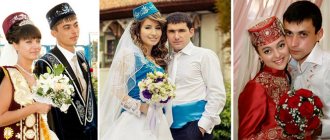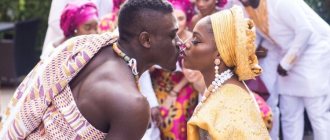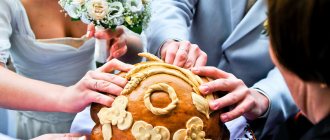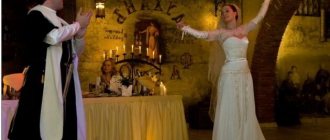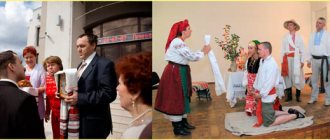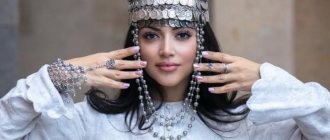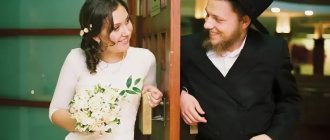Chuvash traditions and customs are associated with the worship of nature spirits, agriculture, seasons, family and continuity of generations. Today the population of the Chuvash Republic is modern democratic people who dress fashionably and actively use the achievements and benefits of technological progress. At the same time, they sacredly honor their culture and historical memory, passing it on from generation to generation.
Several generations in one house
Family is the main value for every Chuvash, therefore family values are revered sacredly. In Chuvash families, spouses have equal rights. Several generations living in the same house are encouraged, so families where grandparents, their grandchildren and great-grandchildren live under the same roof and lead a common life are not uncommon.
The older generation is especially revered. A child and an adult will never use the word “mom” in a sarcastic, humorous, or even more so offensive context. Parents are sacred.
Popular message topics
- The piano and its history
The piano is the most famous keyboard instrument of our time. It has two sides of the same coin - a grand piano and an upright piano. These types of pianos are also keyboard-string instruments. But few people know that the strings in a piano are located - City of Kursk
The oldest Russian city of Kursk was mentioned in chronicles back in 1032. Even then it was considered a major trading city. The year of foundation of the Kursk appanage principality is considered to be 1095, when a powerful fortress was founded here. - Alexander Nevsky in art (his image)
For the first time, Alexander Nevsky was immortalized in the literary work “The Life of Alexander Nevsky” in the 13th century. The work told about the brave exploits of the Novgorod prince.
Wedding dresses
The family begins with a wedding, which is played cheerfully and on a grand scale. Residents from different regions of Russia come to see this action. According to national custom, the groom on the special day should wear an embroidered shirt and caftan, belted with a blue sash. Sometimes the sash is green.
On his head is a fur hat with a coin, and the young man is wearing boots. National costume for all seasons. The groom is prohibited from taking off his hat and caftan - he must wear them until the end of the wedding.
The bride's formal attire consisted of a shirt, an apron, and an embroidered robe. The head was decorated with a cap, hand-embroidered with beads and silver coins. There is a special cape on the shoulder, decorated with silver coins, and multiple decorations on the arms and neck.
There were so many decorations that they often weighed more than 2-3 kg. And the whole outfit weighed 15 kg or more. The coins were sewn on for a reason - when they moved, they emitted a melodious ringing, signaling the approach of the newlywed.
Culture and life of the Chuvash people
The main economic activity of the Chuvash was settled agriculture. Historians note that these people succeeded in land management much more than the Russians and Tatars. This is explained by the fact that the Chuvash lived in small villages with no cities nearby. Therefore, working with the land was the only source of food. In such villages there was simply no opportunity to shirk work, especially since the lands were fertile. But even they could not saturate all the villages and save people from hunger. The main crops grown were: rye, spelt, oats, barley, wheat, buckwheat and peas. Flax and hemp were also grown here. To work with agriculture, the Chuvash used plows, roe deer, sickles, flails and other devices.
Wedding customs
Many ancient traditions are found at Chuvash weddings today. Among them is the meeting of the groom.
- Guests and relatives of the newlywed gather in her house and wait for the groom at the gate. They greet him, as expected, with bread and salt, and also beer.
- In the courtyard, a table is set in advance for the guests - all those who arrived in the wedding cortege must sit down at it and drink to the health of the newlyweds.
- Weddings are celebrated for two days. The first day of fun takes place at the bride's house, on the second day the invitees move to the groom's parental home.
- In the morning after the celebration, the bride is put on a hush-pu - a headdress worn by married ladies.
Chuvash wedding traditions
Chuvash wedding traditions and rituals
Traditional Chuvash wedding ceremonies and rituals have come to this day from ancient times. They arose at the everyday level. For example, bride price and dowry traditionally helped the bride's parents recoup the costs they had invested in the wedding, and served the newlyweds as initial capital for family life. Other traditions arose on religious grounds - they are designed to protect newlyweds from evil forces, to attract happiness and prosperity to a young family. Several weeks pass from matchmaking to marriage in Chuvashia. A string of events takes place in a certain sequence; the observance of traditions is monitored by a relative of the Chuvash newlywed.
Dating, choosing a bride and groom
In the old days, it was customary to look for a companion and life partner in another village, preferably as far as possible from your place of residence. There is a simple explanation for this tradition: this way there is less risk of marrying a relative. After all, a bride and groom living in the same village could be both close and distant relatives, and Chuvash wedding traditions prohibited the marriage of relatives up to the seventh generation.
Therefore, as a rule, several villages participated in national holidays, so that young people from different settlements could get to know each other. In rare cases, parents chose a couple for their children, but even if this was the case, the wedding was not celebrated without the consent of the young people. If a Chuvash girl liked a young man, she would embroider a scarf with her own hands and give it to her chosen one. And the young man, according to tradition, treated the girl he liked with candy, gingerbread and other sweets.
After the guy chose a bride, he told his mother and father about it. The task of the elders was to make sure before the wedding that the son’s chosen one was healthy and had a good upbringing. The future wife underwent the most thorough check in housekeeping. The girl had to be neat and hardworking in order to become a full-fledged mistress in the new house. Older brides were valued more among the Chuvash than young ones, because the former had more dowry and experience in housekeeping.
Matchmaking ritual
The most favorable period for matchmaking among the Chuvash is spring. Following tradition, the guy sent matchmakers to the chosen girl. The delegation for the negotiations was formed as follows:
- the senior groom is a relative of the groom who had to negotiate with the girl’s parents;
- junior groom - he was chosen from the young relatives of the Chuvash groom, he had to negotiate with the bride's retinue, sing songs at the wedding celebration;
- other relatives or good friends.
The number of matchmakers was always odd.
Chuvash matchmakers did not come empty-handed; they brought sweets, fruits, and alcohol with them. The number of gifts was also odd. This Chuvash wedding tradition symbolizes that before matchmaking, the bride and groom are not yet a couple. If the groom’s parents chose a wife, then to the first matchmaking they took their son with them so that he could meet the girl. If he didn’t like her, then it was not too late to refuse the wedding.
At the bride’s house, the Chuvash matchmakers sat down in the middle of the hut and began a sophisticated conversation with the girl’s father, in no hurry to reveal the secret of why they came. Usually they started talking about selling something. The bride's parents also supported the tradition and replied that they were not selling anything. After this, the girl was invited into the room, and the matchmakers told her about the purpose of their visit.
If the answer from the girl’s parents was positive, then a couple of days later the groom’s father and mother came to the bride and brought gifts. They met the girl, negotiated with her relatives about the dowry and bride price. The bride's parents prepared a treat in response, and the girl, observing the Chuvash wedding tradition, presented her future father-in-law with towels and shirts as gifts. At this meeting, the wedding day was already discussed, which was scheduled approximately 3 or 5 weeks after the matchmaking. The number of weeks was necessarily odd.
The Chuvash wedding dowry included household items, clothing, pets and birds. The bride price that the groom gave for the bride included food for the wedding, skins and, of course, money. The tradition of bride price has been preserved by this people to this day, but now the bride is bought from her parents only with money. There is no agreement on their quantity - everyone pays as much as they can. The amount can be very large, but sometimes it is only symbolic, simply as a tribute to tradition.
The bride price is given before the wedding in the bride's house. The girl's parents put bread and salt on the table, and the groom's father puts a wallet with money on the loaf. The bride's father or her elder relative takes the money and gives back a wallet with a coin. It symbolizes the wealth of a young family.
Wedding preparations
Chuvash weddings have always been famous for their variety of rituals and traditions, which differed from each other according to the territory of residence. If a girl was given in marriage by force, and not by consent, the rituals at such a wedding were somewhat different. But this is a separate topic that we will not touch on here.
According to tradition, the wedding ceremony begins simultaneously in two houses - the bride and groom. Then the future spouse goes to his beloved’s house to pick her up from her parents and bring her to his home. This is where the wedding celebration ends.
A few days before the wedding, the Chuvash bride and groom (each in their own village), together with their parents and friends, notified their relatives about the upcoming event. Beer for the wedding was also brewed in advance. And the wedding celebration began with the cleaning of the bathhouse, in which the newlyweds and their relatives should wash. After the Chuvash bride washed herself, she had to go through another bath, which, according to popular belief, cleansed the young woman from evil spirits. After this, the newlyweds dressed in new clothes and asked the old people for their blessing for the wedding.
Chuvash folk song-lamentation
Among the lower and middle lower Chuvash, a ritual was always performed at the wedding ceremony - the crying of the bride. It has been preserved among some Chuvash to this day. Before moving into her husband’s house, the Chuvash bride sings a very sad song, lamenting how she doesn’t want to leave her parents’ house and go to someone else’s, leaving her family behind.
According to tradition, the married sister or other relative began to lament first. She showed the young ones how to do it. Then the bride picked up the sad motive and wailed with tears. At the same time, she recalled her parents, sisters, brothers, her childhood and home. Each Chuvash bride laments differently; improvisation in this matter is encouraged. While sobbing, the young woman hugs all her family and friends and says goodbye to them.
This ritual is also interesting because during it the Chuvash bride brought each guest and relative a ladle of beer into which coins had to be placed. They were called “tribute of lamentation.” After the end of the ceremony, the girl put the coins in her bosom. The bride's crying is not a quick thing; it lasted for several hours. Then the bride was taken to the groom. While the newlywed was lamenting and crying, everyone who was in the house at that time danced and clapped, trying to cheer the bride up.
Wedding at the bride's house
While the guests were gathering, saying prayers for the happiness of the newlyweds, preparing dishes for the festive table and waiting for the groom to arrive, the newlywed and her friends were dressing in a special room. Traditionally, groomsmen had to pay a symbolic fee to the father of the Chuvash bride; this tribute should not be confused with kalym. After the ritual, the guests were allowed into the house, the groom was treated to beer and seated in a place of honor. Before this, the bride's parents put money here, which the groom took away.
The feast began, the guests had fun, danced, then the newlywed came out wearing a special wedding veil. The bride sang a traditional song with lamentations, after which she was taken to her husband’s house. When the wedding carriage left the village, the groom performed a ritual of expelling evil spirits. To do this, he hit his betrothed three times with a whip. The wedding train arrived back with music and songs.
Wedding at the groom's house
Before the celebration, close relatives dressed the groom in a national wedding costume. Then he went into the yard to the guests, and there the fun began. Friends and single guys took part in the dances and songs. After dancing to their heart's content, everyone went into the house to have a little drink. Then the groom's groomsman and the boys went to the bride's house. This procession was accompanied by lively songs and loud music.
The bride left the house in the evening. Following the Chuvash wedding ritual, the bride went to bed with her betrothed's relatives, and the groom's guests and relatives stayed overnight in his house. In the morning everyone went to the church where the wedding ceremony took place. According to tradition, after registering a marriage, the young wife’s veil was removed at home and she was dressed in the attire of a married woman. The wedding continued.
After the wedding ceremony, the newlyweds had to undergo many different rituals. So, at the gate of the house, a raw egg was broken at their feet, and then they were treated to runny scrambled eggs with milk. This ritual was a symbol of a happy life. Then the newlyweds were escorted to the marital bed and left alone in the room for several hours. A matchmaker came to “wake up” the couple.
After the newlyweds were alone, the young wife was sent to the well. The girl had to fill a bucket of water and bring it into the house. During this ritual, the sister-in-law poured water three times, and only on the fourth time was the daughter-in-law given the opportunity to bring water home. After all the main rituals, the Chuvash wedding was celebrated for another day.
Customs after the wedding
In the first three days after marriage, the young wife has no right to clean the house. Close relatives do this for her, and the girl gives them symbolic gifts in gratitude. After the wedding, a Chuvash woman was obliged to give something to her mother-in-law seven times. According to tradition, during the first year of marriage, young matchmakers often go to visit each other in order to strengthen family ties.
A week after the wedding, the newlyweds and their parents visited their father-in-law and mother-in-law. Three weeks later, the spouses visited the parents again, but already took one of their relatives with them. Six months later, 12 people came to visit his father-in-law - the parents of the young husband and close relatives. They stayed there for three days, and then gave the rest of the dowry to the young people. Usually these were pets.
One of the Chuvash wedding traditions forbade young spouses from singing and dancing at the wedding. The belief was that if the husband had a lot of fun at the wedding, then the wife would have to spend difficult years with him. Only on the first visit to the bride's parents after the wedding were the newlyweds allowed to relax a little. Today the Chuvash very rarely observe this tradition: they dance and have fun from the heart after the wedding.
National Chuvash wedding clothes
The Chuvash groom attended the wedding in an embroidered shirt and caftan, which was belted with a green or blue sash. He put boots on his feet. Mandatory accessories for a Chuvash newlywed were also:
- a fur hat with a coin near the forehead;
- gloves;
- neck decoration with beads and coins.
An embroidered scarf, given by the bride during matchmaking, was hung by the groom on his belt at the back. He definitely had a whip in his hands. The young spouse was not allowed to remove all of the listed attributes during the wedding celebration, even if it was very hot.
The Chuvash bride's wedding dress weighed about 15 kg. Approximately three kilograms of silver coins were used to embroider the wedding headdress. The ribbon that was worn over the shoulder was also embroidered with coins. Outerwear, shirts, and aprons were also decorated with embroidery. The following decorations were mandatory accessories for a Chuvash bride's outfit:
- bracelets;
- rings;
- pendants on the chest and belt;
- wallet;
- mirror.
Wedding dresses, especially the bride's cap, were trimmed with beads, shells and coins. The drawings were geometric and carried a secret ritual meaning. The coins were sewn on so that they would ring melodiously as the girl moved. Therefore, it is never quiet at a Chuvash wedding. The bride's traditional wedding veil should be white and embroidered along the edges.
Video: Chuvash ritual before the wedding
A Chuvash wedding is a fun holiday filled with various rites and rituals. The celebration continues for several days, the whole village walks. Today, the Chuvash do not often observe all wedding traditions, but there are customs that they have honored through the centuries. The clothes of the young and the wedding rituals of the Chuvash are always bright and catchy. You can verify this by watching our video.
A crying tribute
This ritual is a continuation of the previous one. While crying, the newlywed hugged relatives and friends, as if saying goodbye. She handed out a ladle of beer to each person who approached her. The guest threw coins at him.
The crying tribute lasted for several hours, after which the girl took out the coins and put them in her bosom. All this time the guests danced, amusing the hero of the occasion. Then the bride was taken to the chosen one’s house.
How does matchmaking and engagement work?
A Chuvash wedding is inextricably linked with the performance of various household traditions and religious rituals. According to the existing traditional canons of peoples
Chuvashia, the groom is recommended to choose a bride from a distant area. This is due to the desire to avoid the risk of marriage between distant relatives. For this reason, villages often organize holidays in which residents of several villages participate.
Young people usually get acquainted at such joint holidays, and older relatives look closely at boys and girls in search of suitable marriage candidates for their adult children. There are individual cases when the choice of the bride was made by the groom's parents, but even in such a situation, mutual consent of the parties is mandatory.
If a guy and a girl like each other, in this case, according to national tradition, the future bride presents the groom with a self-embroidered scarf as a gift, and the future groom treats her with delicious gifts.
After exchanging traditional signs of attention, which indicate the mutual sympathy of the young people, the groom informs his parents of his choice.
Parents, in turn, ask friends about their future daughter-in-law in order to make sure that their son will bring into the house a well-mannered and healthy girl who will be able to give birth to healthy children who will continue the family line.
This wish arises for a reason, because the future daughter-in-law will have a large range of household responsibilities, and she will have to be a full-fledged mistress of the house. There is an interesting feature that more mature brides are in greater “demand”, since they have more solid experience in housekeeping, and they have a much larger dowry. A young couple in which a 20-year-old groom marries a 30-year-old bride is a common occurrence in Chuvash families.
According to folk tradition, the Chuvash choose the spring time for matchmaking, when after a long winter nature blooms, and young people have time for walks and acquaintances before the start of spring field work.
For summer weddings, the time was chosen after the end of spring work in the field, and for autumn weddings, after the harvest. They tried not to hold weddings on major religious holidays.
Subsequent matchmaking is carried out as follows: a group of matchmakers, consisting of the groom’s relatives, goes to the house of his chosen one.
There is one peculiarity - the number of matchmakers must be odd. The matchmakers came to the bride's house with gifts and strong drinks.
In some cases, the groom was also taken to matchmaking. This was done if the bride was chosen by the parents, and the groom had not yet seen his betrothed. If for some reason the groom did not like the young woman at the screening, he had every right to abandon his intentions. In the bride's house, the matchmakers began a meaningless conversation with the bride's parents, without naming the true purpose of their visit.
Then they invited the bride and in her presence announced the purpose of their visit.
If the bride and the bride’s parents were not against it, then a date was set for a return visit of the bride’s close relatives to the groom’s house in order to consolidate the acquaintance.
During matchmaking, the bride's close relatives announced the amount of her dowry, and the groom's parents announced what price they would give for the bride.
The dowry included a set of clothes, kitchen utensils, and livestock. The groom's family prepared a monetary dowry, as well as food for the wedding feast.
At present, the concepts of “price and dowry” have been preserved, and have only changed slightly: the universal monetary equivalent is considered the measure of their measurement. The transfer of money is carried out a few days before the wedding on the eve of the wedding celebrations as follows: the bride’s relatives set the table and put bread and salt in the center, which the groom’s relatives cover with a purse with kalym.
The head of the bride's clan takes the bride price and returns the wallet to the groom's relatives with an enclosed coin, which symbolizes the endless financial well-being of the young family. If both parties came to a mutual agreement, then the relatives exchanged small gifts. At this meeting, the wedding date was set - usually in 3-5 weeks, but always in an odd number of days.
The groom's dowry and the bride's dowry can be attributed to long-standing family traditions; rituals of protection from evil spirits and attracting happiness to a new family are ancient religious rituals
Strengthening the marriage
For three days after the wedding and the ceremonial banquet, the newly-made wife should not clean the house - the dirty work is done by relatives these days. The young wife thanks her with gifts. After the wedding, the daughter-in-law must give seven gifts to her mother-in-law.
In the first year, related families often visit each other. This is done for the sole purpose of establishing contact and strengthening kinship.
A week after the wedding, the newlyweds come to visit their father-in-law. Three weeks later - a second visit to him, and after 6 months already 12 people are coming to visit: young spouses, in-laws.
The duration of the last visit is 3 days. With treats, conversations, songs, dances. The young family received the rest of the dowry on this visit - livestock.
Kinship is one of the best and most sacredly revered traditions among the Chuvash. Perhaps this is why the families of the representatives of the people are strong, divorces occur much less frequently than among other nationalities living in the Russian Federation, and mutual understanding and connection between generations is not an empty phrase.
What words describe the life of the Chuvash in the old days. Chuvash: history and traditions of the people
September 13, 2016
Chuvash (self-name - chăvash, chăvashsem) are the fifth largest people in Russia. According to the 2010 census, 1 million 435 thousand Chuvash live in the country. Their origin, history and peculiar language are considered very ancient.
According to scientists, the roots of this people are found in the ancient ethnic groups of Altai, China, and Central Asia. The closest ancestors of the Chuvash are considered to be the Bulgars, whose tribes inhabited a vast territory from the Black Sea region to the Urals . After the defeat of the Volga Bulgaria state (14th century) and the fall of Kazan, part of the Chuvash settled in the forest regions between the Sura, Sviyaga, Volga and Kama rivers, mixing there with Finno-Ugric tribes.
The Chuvash are divided into two main subethnic groups in accordance with the course of the Volga:
the upper (viryal, turi) in the west and north-west of Chuvashia, the lower (anatari) in the south, in addition to them in the center of the republic there is a group of middle lower (anat enchi).
In the past, these groups differed in their way of life and material culture. Now the differences are becoming more and more smoothed out. The self-name of the Chuvash, according to one version, directly goes back to the ethnonym of a part of the “Bulgar-speaking” Turks: *čōš → čowaš/čuwaš → čovaš/čuvaš. In particular, the name of the Savir tribe (“Suvar”, “Suvaz” or “Suas”), mentioned by Arab authors of the 10th century (Ibn Fadlan), is considered by many researchers to be a Turkic adaptation of the Bulgarian name “Suvar”.
In Russian sources, the ethnonym “Chuvash” first appears in 1508. In the 16th century, the Chuvash became part of Russia, and at the beginning of the 20th century they received autonomy: from 1920, the Autonomous Region, from 1925 - the Chuvash Autonomous Soviet Socialist Republic. Since 1991 - the Republic of Chuvashia as part of the Russian Federation. The capital of the republic is Cheboksary.
Where do the Chuvash live and what language do they speak?
The bulk of the Chuvash (814.5 thousand people, 67.7% of the region’s population) live in the Chuvash Republic. It is located in the east of the East European Plain, mainly on the right bank of the Volga, between its tributaries Sura and Sviyaga. In the west, the republic borders with the Nizhny Novgorod region, in the north - with the Republic of Mari El, in the east - with Tatarstan, in the south - with the Ulyanovsk region, in the southwest - with the Republic of Mordovia. Chuvashia is part of the Volga Federal District.
Outside the republic, a significant part of the Chuvash live compactly in
Tatarstan (116.3 thousand people), Bashkortostan (107.5 thousand), Ulyanovsk (95 thousand people) and Samara (84.1 thousand) regions, in Siberia .
A small part is outside the Russian Federation, the Chuvash language belongs to the Bulgar group of the Turkic language family and represents the only living language of this group. In the Chuvash language, there is a high (“pointing”) and a lower (“pointing”) dialect. On the basis of the latter, a literary language was formed. The earliest was the Turkic runic alphabet, replaced in the X-XV centuries. Arabic, and in 1769-1871 - Russian Cyrillic, to which special characters were then added.
Features of the appearance of the Chuvash
From an anthropological point of view, most Chuvash belong to the Caucasoid type with a certain degree of Mongoloidity. Judging by research materials, Mongoloid features dominate in 10.3% of the Chuvash. Moreover, about 3.5% of them are relatively pure Mongoloids, 63.5% belong to mixed Mongoloid-European types with a predominance of Caucasoid features, 21.1% represent various Caucasoid types, both dark-colored and fair-haired and light-eyed, and 5.1 % belong to the sublaponoid type, with weakly expressed Mongoloid characteristics.
From a genetic point of view, the Chuvash are also an example of a mixed race - 18% of them carry the Slavic haplogroup R1a1, another 18% carry the Finno-Ugric N, and 12% carry the Western European R1b. 6% have the Jewish haplogroup J, most likely from the Khazars. The relative majority - 24% - bears haplogroup I, characteristic of northern Europe.
